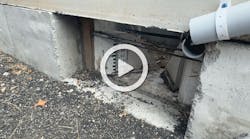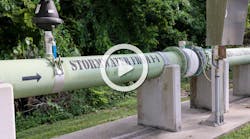Asset management – the critical missing element in stormwater
The practice of asset management is well understood and consistently applied in the drinking water and wastewater sectors, but asset management is less developed in the stormwater sector.
The results of the 2022 Water Environment Federation (WEF) National MS4 Needs Assessment Survey reflect that less than half of MS4 programs have an asset management program. It is likely that among those with an asset management plan, many are not robust compared to more well-established infrastructure sectors. But this is starting to change. The experience of one North Carolina community highlights the path forward.
Fuquay-Varina’s MS4 asset management journey begins
MS4s are designed to convey stormwater runoff efficiently and effectively from crowded roadways to the wide-open spaces of the local stream or lake. While MS4s convey stormwater, they also have the potential to transport pollutants that can reduce the quality of receiving water. Operators must consider employing a structured asset management approach to prepare for future development and the increased stormwater discharge volumes while maintaining the quality of stormwater discharged from the MS4.
Fuquay-Varina, North Carolina, is undertaking an asset management journey to inventory older, unmapped infrastructure in the town’s two downtowns to implement an approach to managing its MS4 assets. The town has a robust inventory of assets except for those downtown areas, and this project will fill the gap.
- The town’s MS4 program strategy includes several essential components:
MS4 O&M Program: Plans for maintaining the stormwater collection system include regular inspections and maintenance of catch basins and conveyance systems. - Municipal Stormwater Control Measures (SCM) O&M Program: Fuquay-Varina manages municipally owned SCMs to comply with post-construction site runoff controls. The town keeps an inventory of SCMs and performs regular inspections and maintenance.
- Facilities Operation and Maintenance (O&M) Program: This program ensures that town-owned and operated facilities do not contribute to stormwater pollution. Regular facility inspections and maintenance and annual staff training on stormwater awareness are central components.
- Spill Response Program: Procedures established for preventing and responding to spills that could contaminate stormwater runoff are maintained at town facilities, and staff receive annual training on spill response.
- Pesticide, Herbicide, and Fertilizer Management Program: Adequately training and certifying employees who use landscape chemicals helps minimize water quality impacts from these substances.
- Vehicle and Equipment Maintenance Program: Measures are in place to prevent stormwater contamination from equipment maintenance areas. Vehicles are routinely inspected and taken to private auto mechanics for maintenance, and pollution prevention training is conducted for relevant staff.
- Pavement Management Program: This element of the proactive plan for MS4 system maintenance aims to reduce pollution in stormwater runoff from municipally owned streets, roads, and parking lots.
The town’s approach aligns with the requirements of the North Carolina Department of Environmental Quality and the National Pollutant Discharge Elimination System permit regulations.
Drivers of successful infrastructure asset management
These nine drivers should be considered when developing an asset management plan:
- improved financial performance
- informed asset investment decisions
- enhanced risk management
- improved service
- increased efficiency and effectiveness
- regulatory compliance
- enhanced organizational reputation
- improved organizational sustainability, and
- proactive social responsibility.
Because these considerations often stem from regulatory requirements, environmental protection rules, and community expectations, systems have flexibility to tailor their asset management approach to their situation.
Asset management program development
By incorporating asset management principles into the MS4 program strategy, the town will be able to better project and manage long-term costs, improve system performance, minimize risk and meet compliance requirements. Asset Management of MS4 typically involves these steps:
- Asset Inventory and Data Gathering: Create a comprehensive inventory of all stormwater assets and gather relevant data on their condition and performance. This can be accomplished by leveraging geographic information system (GIS) technology to capture spatial data.
- Condition and Criticality Scoring: Weigh known assets based on their condition and criticality to the system’s overall performance.
- Establish Levels of Service: Define the performance standards and service levels that the stormwater system must meet, including maintenance frequency and the quality of stormwater treatment.
- Risk-Based Analysis: Analyze the risks associated with each asset, considering the likelihood and consequence of failure, to inform decision-making.
- Policies and Strategies: Develop policies and strategies, including financial, staffing, and tactical plans, that align with the asset management plan (AMP) goals.
- Financial Planning: Implement a long-term financial strategy to fund the AMP, including user fees, grants, bonds, and public-private partnerships.
- Monitoring and Adjustments: Track progress toward measurable goals and adjust the AMP as necessary.
By following these methodologies, the Town of Fuquay-Varina, and all MS4 managers, can ensure their systems are cost-effectively well-maintained, compliant with regulations, and capable of providing the desired level of service to their communities.
Resources
- https://www.fuquay-varina.org/1434/Pollution-Prevention-and-Good-Housekeepi
- https://files.nc.gov/ncdeq/NCS000504_TOFV%202021%20Draft%20MS4%20Permit_20210721.pdf
- https://www.deq.nc.gov/about/divisions/energy-mineral-and-land-resources/stormwater/stormwater-program/npdes-ms4-program-0
- Spiderweb (freese.com)
- MS4 Compliance and Stormwater Asset Management - Freese and Nichols
About the Author
Seth Brown
Seth Brown has over 25 years of experience in the water sector and is the Principal and Founder of Storm and Stream Solutions, LLC, a consulting firm providing a range of services from policy and alternative project delivery analysis in the stormwater sector to facilitation and training services focused on stormwater topics. He was the Director of Stormwater Programs at the Water Environment Federation from 2010-2015 and is currently the Executive Director of the National Municipal Stormwater Alliance, which is a 501.c.3 representing stormwater-focused organizations in 24 states across 9 of the 10 U.S. EPA regions with a network that is comprised of over 4,000 MS4s.
Seth has a Ph.D. in civil engineering from George Mason University with a research focus on socio-economic modeling of incentive-based investments of green stormwater infrastructure on private properties. He leads courses in Green Infrastructure and Innovative Water Partnerships at Virginia Tech and the University of Maryland at Eastern Shore and is a licensed professional engineer in the state of Maryland.
Trey Shanks
Trey Shanks is vice president/principal at Freese and Nichols Inc. Shanks can be reached at [email protected].
Jennifer Mitchell
Jennifer Mitchell is environmental program coordinator for the Town of Fuquay-Varina. Mitchell can be reached at [email protected].



